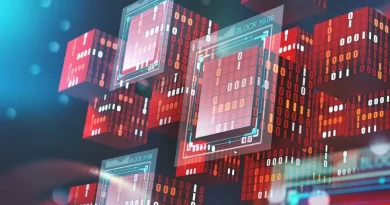The Power of Blockchain and Cryptocurrency: Exploring the Interdependence and Coexistence
Blockchain and cryptocurrency synergize to disrupt industries, driving innovation and collaboration in the digital era. This article explores their interdependence, offering insights for technology innovators. Discover how blockchain empowers cryptocurrencies and unlocks new possibilities for Generative AI researchers and professionals in the evolving digital landscape.
In today’s dynamic digital landscape, the concepts of blockchain and cryptocurrency have emerged as transformative forces, reshaping industries across the board. This article delves into the intricate relationship between blockchain technology and cryptocurrency, unveiling their interdependence and highlighting the immense potential for coexistence. By providing valuable insights, this piece aims to empower technology innovators, researchers, and professionals interested in the world of Generative AI.
Understanding Blockchain Technology
The Fundamentals of Blockchain
Blockchain technology serves as the cornerstone of a decentralized and immutable ledger system, ushering in a new era for recording transactions with exceptional transparency and security. At its core, blockchain operates on a foundation of cryptographic algorithms and consensus mechanisms, forging an ecosystem that guarantees unrivaled data integrity while safeguarding against tampering and fraudulent activities.
By embracing decentralization, blockchain disrupts traditional centralized systems by distributing transactional information across a network of computers, known as nodes. This innovative approach eliminates the need for a central authority, empowering participants to collectively validate and authenticate transactions. As a result, trust is no longer reliant on intermediaries but is instead established through a consensus mechanism that ensures the accuracy and validity of each transaction.
Cryptographic algorithms play a vital role in securing the data stored on the blockchain. These algorithms encrypt information, rendering it unreadable without the corresponding cryptographic key. Through this encryption process, blockchain safeguards sensitive data from unauthorized access, bolstering the overall security of the system.
Consensus mechanisms are integral to blockchain’s ability to maintain the integrity of the ledger. They ensure that all nodes within the network agree on the validity of transactions and the order in which they are added to the blockchain. Consensus mechanisms, such as Proof of Work (PoW) and Proof of Stake (PoS), serve as algorithms that enable network participants to reach a consensus by dedicating computational power or staking cryptocurrency. This collective agreement guarantees that only legitimate transactions are added to the blockchain, fortifying its integrity and preventing fraudulent activities.
By intertwining cryptographic algorithms and consensus mechanisms, blockchain technology establishes an ecosystem that inspires trust among participants. The transparency of the ledger allows anyone to verify transactions, ensuring accountability and reducing the potential for fraud. The immutability of the recorded data ensures that once a transaction is added to the blockchain, it becomes permanent and cannot be altered retrospectively, fostering an environment of reliability and verifiability.
Key Features and Benefits
When delving deeper into the essence of blockchain technology, we uncover a diverse array of key features that not only define its significance but also revolutionize the way we perceive data integrity and trust. These essential characteristics provide a solid foundation for industries seeking enhanced security and transparency. Let’s explore them further:
Transparency
The Cornerstone of Blockchain’s Strength At the core of Blockchain lies its inherent transparency, which promotes a new level of openness and accountability. Unlike traditional systems where information is centralized and opaque, blockchain offers a revolutionary approach by providing a public ledger accessible to all participants. Every transaction, once recorded on the blockchain, becomes permanently etched in its digital fabric, enabling anyone to trace and validate the entire transaction history. This transparency fosters trust, as it allows individuals to verify and scrutinize data, ensuring its authenticity.
Security Measures
Safeguarding Data with Advanced Cryptography Blockchain’s security measures are fortified by advanced cryptographic techniques, ensuring data protection against unauthorized access and tampering. The integration of cryptographic algorithms within the blockchain infrastructure provides an added layer of defense, making it exceedingly challenging for malicious actors to compromise the system. Encryption techniques secure the data being transmitted and stored within the blockchain, guaranteeing its confidentiality. Additionally, cryptographic hashing algorithms maintain the integrity of data by generating unique digital signatures for each transaction block, detecting any unauthorized modifications.
Immutability
Preserving Permanence and Integrity Immutability is a fundamental characteristic of blockchain technology, serving as the guardian of data permanence and integrity. Once a transaction is added to the blockchain, it becomes practically impossible to alter or delete it without detection. Each block in the chain contains a reference to the previous block, creating a chronological and unbroken sequence of transactions. Any attempt to modify a previous block would require altering all subsequent blocks, making the task computationally infeasible. This immutability feature ensures that the data recorded on the blockchain remains tamper-proof, providing an unalterable source of truth and bolstering trust among participants.
Decentralization
Empowering Resilient and Inclusive Networks Another pivotal feature of blockchain is its decentralized nature, eliminating the reliance on a single governing entity. Instead, the power and control are distributed across a network of nodes, with each node maintaining a copy of the entire blockchain. This decentralization fosters a resilient and inclusive environment, as no single point of failure exists within the system. It mitigates the risks associated with central authorities and provides increased resistance to cyber attacks or malicious activities. Moreover, decentralization promotes a collaborative and egalitarian network, where participants have equal access and influence, fostering a sense of empowerment and fairness.
Exploring the Synergy between Blockchain and Cryptocurrency
The Inseparable Link: Blockchain as the Backbone of Cryptocurrency
Cryptocurrency stands as a groundbreaking innovation that owes its existence to the underlying infrastructure of blockchain technology. This inseparable connection between the two is a testament to the profound impact they have on each other and the digital landscape as a whole. By harnessing the capabilities of blockchain, cryptocurrency empowers secure and peer-to-peer transactions, effectively bypassing the need for intermediaries like traditional banks. The advent of Bitcoin, which spearheaded the cryptocurrency revolution, played a pivotal role in paving the way for the emergence of a diverse array of digital assets.
Blockchain technology serves as the bedrock upon which the entire cryptocurrency ecosystem is built. Its decentralized and transparent nature provides the perfect foundation for the secure and efficient exchange of digital currencies. Through blockchain’s distributed ledger, transactions are recorded, validated, and permanently stored in a transparent manner, ensuring accountability and trust among participants. This removes the reliance on centralized authorities and intermediaries, opening up new realms of possibilities for financial interactions.
The use of blockchain technology in cryptocurrency transactions ensures the integrity and immutability of the data. By leveraging cryptographic algorithms and consensus mechanisms, blockchain safeguards against tampering, fraud, and unauthorized access. The decentralized nature of blockchain networks makes them highly resilient to attacks, providing enhanced security for cryptocurrency transactions.
The emergence of Bitcoin as the first cryptocurrency disrupted traditional notions of currency and finance. Bitcoin’s success showcased the immense potential of digital currencies and set the stage for the development of numerous other cryptocurrencies. These digital assets, built on blockchain technology, offer unique functionalities, use cases, and economic models. From utility tokens that grant access to specific services, to security tokens representing ownership in real-world assets, the diverse range of digital assets owes its existence to the foundational breakthroughs achieved by Bitcoin.
The symbiotic relationship between blockchain and cryptocurrency has far-reaching implications. Blockchain technology enables the secure and efficient operation of cryptocurrencies, while cryptocurrencies, in turn, drive the adoption and proliferation of blockchain technology across various industries. This interdependence has sparked innovation and triggered a wave of transformative applications beyond the realm of finance, including supply chain management, healthcare, voting systems, and intellectual property rights management.
Fostering Economic Activities: Cryptocurrency’s Role in Blockchain Ecosystems
Cryptocurrencies, acting as dynamic mediums of exchange, play a pivotal role within the expansive realm of blockchain ecosystems. They not only facilitate seamless transactions but also serve as powerful incentives for participants, igniting a flurry of economic activities within decentralized networks. These digital assets, representing reliable measures of value, fuel innovation, and drive collaborations, ushering in a new era of transformative possibilities.
Mediating Transactions: Empowering Seamless Exchanges
Cryptocurrencies, built upon the foundation of blockchain technology, act as catalysts for frictionless transactions within blockchain ecosystems. By leveraging cryptographic principles, they enable secure and direct peer-to-peer transfers, eliminating the need for intermediaries. This newfound efficiency empowers individuals and businesses alike to engage in transactions with unparalleled ease and speed.
Incentivizing Participation: Igniting Motivation for Active Involvement
Within blockchain ecosystems, cryptocurrencies play a critical role in incentivizing participants to actively contribute and engage in the network’s operations. Through various mechanisms such as mining, staking, or participating in consensus protocols, individuals are rewarded with cryptocurrencies for their efforts, thereby encouraging continued involvement and dedication to the network’s growth.
Stimulating Economic Activities: Unleashing a Wave of Innovation
Cryptocurrencies, with their inherent value and utility, stimulate economic activities within decentralized networks. As these digital assets gain acceptance and adoption, they create a vibrant ecosystem where individuals and businesses leverage their potential for diverse economic endeavors. From online marketplaces and decentralized finance (DeFi) platforms to crowdfunding initiatives and tokenized assets, cryptocurrencies spark innovation and provide new avenues for value creation.
Fueling Collaborations: Building Bridges across Decentralized Networks
Cryptocurrencies act as bridges, connecting individuals and entities within blockchain ecosystems. By establishing shared measures of value, these digital assets foster collaboration and cooperation among participants. Smart contracts, enabled by cryptocurrencies, facilitate secure and transparent agreements, driving synergistic partnerships and unlocking opportunities for joint ventures, research collaborations, and the development of novel blockchain-based solutions.
The Advancements of Generative AI and Its Synergy with Blockchain
Unlocking New Horizons: The Intersection of Generative AI and Blockchain
The rapid advancements in the field of Generative AI have ushered in a new era of innovation, unveiling extraordinary possibilities. However, it is the convergence with blockchain technology that propels this synergy to unprecedented heights. Blockchain emerges as a key enabler, empowering technology innovators and researchers to explore uncharted territories and fuel groundbreaking developments in the realm of Generative AI.
Harnessing the Power of Decentralized Storage
In the realm of Generative AI, vast amounts of data are essential for training sophisticated models and achieving remarkable outcomes. Blockchain’s decentralized storage capabilities provide an ideal solution for securely storing and accessing this voluminous data. By leveraging a distributed network of nodes, blockchain ensures redundancy, fault tolerance, and tamper-resistant data storage. This paves the way for scalable Generative AI applications that thrive on the availability of diverse and abundant datasets.
Enhanced Data Privacy and Security
As Generative AI delves into increasingly sensitive domains, the protection of data privacy becomes paramount. Blockchain technology, with its inherent security features, establishes a robust foundation for safeguarding sensitive information. By utilizing cryptographic algorithms and consensus mechanisms, blockchain ensures data integrity, confidentiality, and immutability. This fortification against unauthorized access and tampering instills trust among stakeholders, facilitating secure collaborations and empowering researchers to push the boundaries of Generative AI.
Enabling Collaborative Innovation
The convergence of Generative AI and blockchain not only enhances data storage and security but also fosters a culture of collaborative innovation. Blockchain’s decentralized nature eliminates the need for intermediaries and establishes a peer-to-peer network, where researchers, developers, and stakeholders can come together seamlessly. This facilitates the exchange of ideas, sharing of resources, and the collaborative development of AI models. Through secure smart contracts, blockchain enables transparent and auditable collaborations, ensuring fair distribution of intellectual property rights and incentivizing contributions within the Generative AI community.
Unleashing Novel Applications
The intersection of Generative AI and blockchain holds the promise of unlocking novel applications that were previously unimaginable. Through the secure and decentralized nature of blockchain, AI-generated content can be verified, ensuring the authenticity and trustworthiness of digital assets. Industries such as digital media, art, gaming, and advertising stand to benefit from the creation and exchange of unique AI-generated content, powered by the synergy of Generative AI and blockchain. Furthermore, the combination of Generative AI and blockchain can lead to the development of decentralized AI marketplaces, where AI models and services can be shared, traded, and utilized by a broader audience.
Exploring Future Possibilities
Shaping Industries: Evolutionary Trends and Collaborations
As we witness the ongoing revolution of blockchain and cryptocurrency, their transformative impact reverberates across a wide array of industries. However, it is through collaborations between blockchain-based platforms and Generative AI researchers that the true potential of this technology convergence emerges, reshaping sectors such as finance, supply chain management, healthcare, and beyond. These collaborative efforts hold immense promise, paving the way for groundbreaking applications that are set to redefine the future.
Finance: Disrupting Traditional Systems
In the realm of finance, the marriage of blockchain and Generative AI brings forth revolutionary advancements. By combining the transparency and security of blockchain with the intelligence and creative power of Generative AI, new possibilities emerge. Secure and immutable transactions, smart contract automation, and decentralized financial systems are just a few examples of how this collaboration can transform traditional financial processes, fostering efficiency, reducing costs, and increasing accessibility.
Supply Chain Management: Enhancing Transparency and Traceability
The supply chain industry stands to benefit greatly from the synergy between blockchain and Generative AI. By leveraging blockchain’s immutable ledger, supply chain participants can achieve unprecedented transparency and traceability. Incorporating Generative AI into this equation opens doors to predictive analytics, optimization of logistical operations, and real-time tracking, thereby revolutionizing the industry’s efficiency, reducing fraud, and ensuring the ethical sourcing of goods.
Healthcare: Empowering Data Privacy and Medical Research
In the healthcare sector, the convergence of blockchain and Generative AI holds immense potential for transformative advancements. Blockchain’s decentralized architecture and cryptographic security can protect sensitive medical data, ensuring privacy and consent. Generative AI, when applied to healthcare, enables the creation of AI models that generate insights, diagnose diseases, and assist in medical research. The collaboration between these technologies paves the way for secure and privacy-preserving health data exchange, innovative treatment approaches, and personalized healthcare solutions.
Beyond: Exploring New Frontiers
The transformative impact of blockchain and Generative AI extends far beyond the aforementioned sectors. As industries continue to embrace these technologies, their collaborative potential can revolutionize fields such as energy, education, entertainment, and governance. From decentralized energy grids and AI-powered personalized learning platforms to secure content distribution and transparent voting systems, the possibilities are vast and inspiring.
In the realm of blockchain and cryptocurrency coexistence, a realm rich with endless opportunities, it is crucial to address the challenges that arise to ensure sustainable growth and long-term success. By carefully considering and proactively tackling key obstacles, we can forge a path towards a future where these technologies thrive. This section explores the challenges of scalability, energy consumption, regulatory frameworks, and public acceptance, highlighting their significance in navigating the ever-evolving landscape effectively.
Scalability: Building Robust Foundations for Expansion
One of the pressing challenges facing blockchain and cryptocurrency is scalability. As these technologies gain broader adoption, the demand for efficient and high-throughput networks increases. Finding solutions to enhance scalability without compromising the core principles of decentralization and security is paramount. Researchers, innovators, and industry leaders are actively exploring approaches like layer-two protocols, sharding, and consensus mechanism enhancements to address this challenge.
Energy Consumption: Striving for Sustainable Solutions
Another challenge that requires immediate attention is the environmental impact associated with blockchain technology and cryptocurrency mining. The energy-intensive nature of certain consensus algorithms, such as proof-of-work, raises concerns regarding carbon footprint and sustainability. As responsible stewards of technology, efforts are underway to develop and implement greener alternatives, such as proof-of-stake or energy-efficient consensus mechanisms. These innovations aim to minimize energy consumption while maintaining network security and integrity.
The decentralized and borderless nature of blockchain and cryptocurrency presents unique challenges in terms of regulation. Governments and regulatory bodies worldwide are grappling with the need to strike a balance between fostering innovation and protecting consumers. Establishing clear and comprehensive regulatory frameworks that promote fair practices, mitigate risks, and encourage responsible use is crucial. Collaboration between industry stakeholders, policymakers, and regulators is key to developing effective frameworks that provide legal clarity while fostering innovation.
Public Acceptance: Building Trust and Overcoming Skepticism
The success and widespread adoption of blockchain and cryptocurrency rely heavily on public acceptance. While these technologies hold immense potential, public skepticism and misconceptions persist. Educating the public about the benefits, use cases, and underlying mechanisms of blockchain and cryptocurrency is vital. Emphasizing security, privacy, and user-centric approaches can help build trust and confidence among individuals and organizations. Additionally, fostering transparent communication, addressing concerns, and actively engaging with communities can help bridge the gap between technology enthusiasts and the wider public.
The intricate relationship between blockchain and cryptocurrency reveals their profound interdependence, revolutionizing the digital landscape. By comprehending this synergy, technology innovators, researchers, and professionals interested in Generative AI can unlock untapped potential for innovation, collaboration, and the creation of decentralized solutions that shape the future of various industries.




